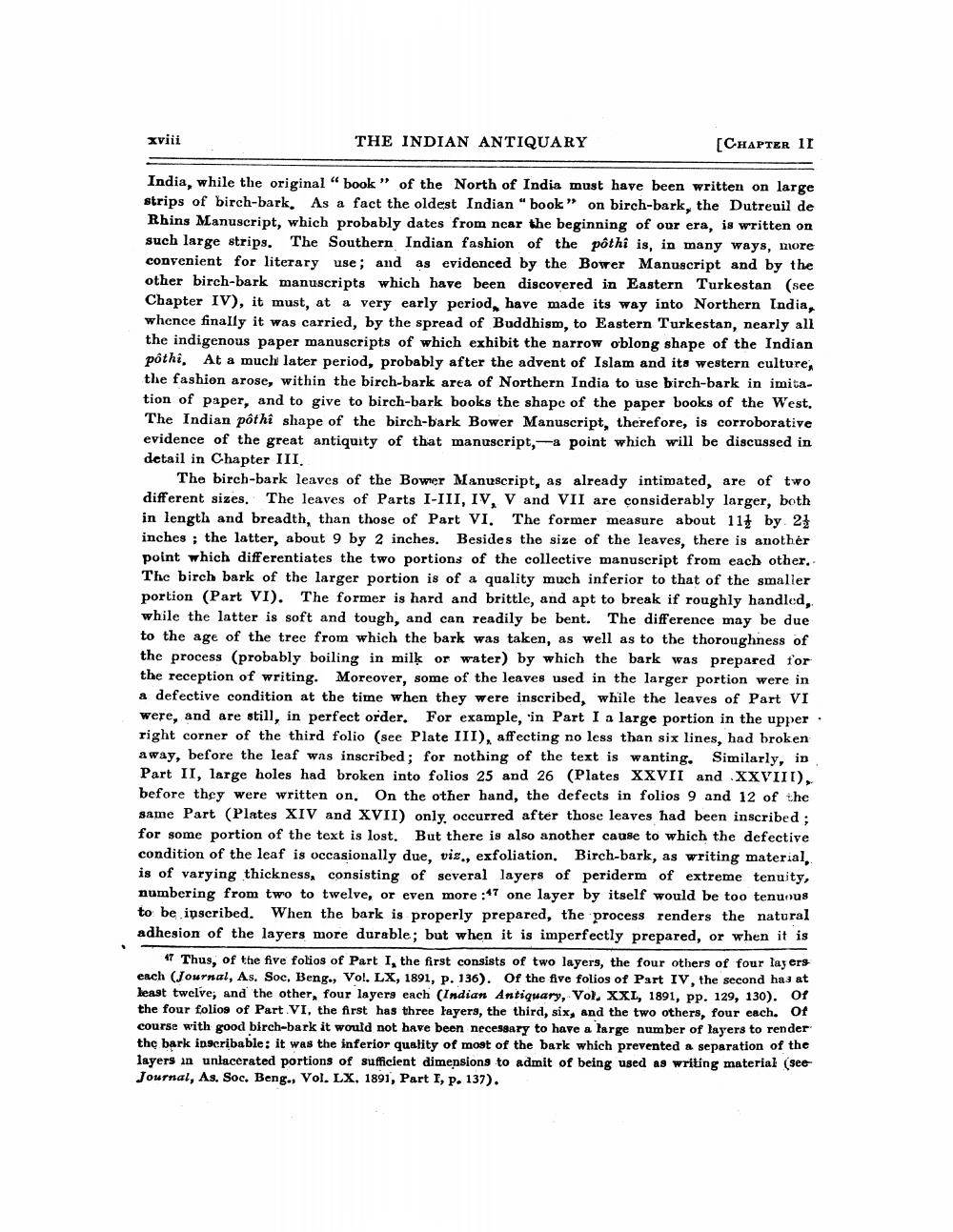________________
xviii
THE INDIAN ANTIQUARY
[CHAPTER 11
India, while the original "book" of the North of India must have been written on large strips of birch-bark. As a fact the oldest Indian "book" on birch-bark, the Dutreuil de Rhins Manuscript, which probably dates from ncar the beginning of our era, is written on such large strips. The Southern Indian fashion of the pôthi is, in many ways, more convenient for literary use; and as evidenced by the Bower Manuscript and by the other birch-bark manuscripts which have been discovered in Eastern Turkestan (see Chapter IV), it must, at a very early period, have made its way into Northern India, whence finally it was carried, by the spread of Buddhism, to Eastern Turkestan, nearly all the indigenous paper manuscripts of which exhibit the narrow oblong shape of the Indian pôthi, At a much later period, probably after the advent of Islam and its western culture, the fashion arose, within the birch-bark area of Northern India to use birch-bark in imitation of paper, and to give to birch-bark books the shape of the paper books of the West, The Indian pộthe shape of the birch-bark Bower Manuscript, therefore, is corroborative evidence of the great antiquity of that manuscript,-a point which will be discussed in detail in Chapter III.
The birch-bark leaves of the Bower Manuscript, as already intimated, are of two different sizes. The leaves of Parts I-III, IV, V and VII are considerably larger, both in length and breadth, than those of Part VI. The former measure about 114 by 2 inches; the latter, about 9 by 2 inches. Besides the size of the leaves, there is another point which differentiates the two portions of the collective manuscript from each other, The birch bark of the larger portion is of a quality much inferior to that of the smaller portion (Part VI). The former is hard and brittle, and apt to break if roughly handled, while the latter is soft and tough, and can readily be bent. The difference may be due to the age of the tree from which the bark was taken, as well as to the thoroughness of the process (probably boiling in milk or water) by which the bark was prepared for the reception of writing. Moreover, some of the leaves used in the larger portion were in a defective condition at the time when they were inscribed, while the leaves of Part VI were, and are still, in perfect order. For example, 'in Part I a large portion in the upper right corner of the third folio (see Plate III), affecting no less than six lines, had broken away, before the leaf was inscribed; for nothing of the text is wanting. Similarly, in Part II, large holes had broken into folios 25 and 26 (Plates XXVII and .XXVIII), before they were written on. On the other hand, the defects in folios 9 and 12 of the same Part (Plates XIV and XVII) only, occurred after those leaves had been inscribed ; for some portion of the text is lost. But there is also another cause to which the defective condition of the leaf is occasionally due, vie., exfoliation. Birch-bark, as writing material, is of varying thickness, consisting of several layers of periderm of extreme tenuity, numbering from two to twelve, or even more :47 one layer by itself would be too tenumus to be inscribed. When the bark is properly prepared, the process renders the natural adhesion of the layers more durable; but when it is imperfectly prepared, or when it is
47 Thus, of the five folios of Part I, the first consists of two layers, the four others of four layers ench (Journal, As, Soc, Beng., Vol. LX, 1891, p. 136). Of the five folios of Part IV, the second has at least twelve, and the other, four layers each (Indian Antiquary, Vol. XXL, 1891, pp. 129, 130). Of the four folios of Part VI, the first has three layers, the third, six, and the two others, four each. Of course with good birch-bark it would not have been necessary to have a large number of layers to render the bark inscribable: it was the inferior quality of most of the bark which prevented a separation of the layers an unlacerated portions of sufficient dimensions to admit of being used as writing material (see Journal, As. Soc. Beng., Vol. LX, 1891, Part I, p. 137).




